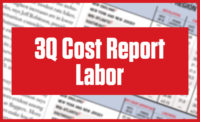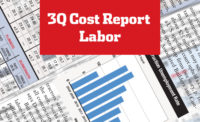Concerns about workforce shortages appear to be easing during the coronavirus pandemic, but compensation for hourly workers is holding steady. Despite some delays and cancellations, many projects on the books before spring shutdowns are moving ahead. As a result, statistics show union and nonunion contractors—on average—continue to offer stable yearly compensation hikes.
About 52% of contractors still have a hard time filling some or all hourly craft positions, says the most recent workforce survey by the Associated General Contractors of America and Autodesk, the lowest level of reported shortage since the measure began in 2013. By comparison, 80% of firms reported difficulty filling craft positions in the 2018 and 2019 surveys.
In this year’s report, 60% of firms had at least one unfilled hourly craft position as of June 30. Ken Simonson, AGC chief economist, says that in 2019, firms reported 19 of 20 possible craft positions as hard to fill. In 2020, they cite shortages in fewer than half. Laborers, carpenters and equipment operators are the most difficult positions to fill. “Firms still are having trouble filling positions, so they may have to pay more to get those workers,” he says. “Cost pressures haven’t disappeared.” While the survey showed pay increases were “somewhat less common compared to 2019,” Simonson adds, almost no firms reported reductions.
Nonunion firm compensation for hourly craftworkers “appears to be relatively stable,” says Jeff Robinson, president of compensation research firm PAS. In 2019, average wage hikes were 3.26%, according to its Merit Shop Wage and Benefit Survey. This year, firms estimate hourly raises of 2.91%. “That is a safe projection for what should be the actual average increase in 2020,” he says.
|
Related Link |
Union Pact Stability
Among union craftworkers who work under multiyear labor contracts, current settlement increases appear to be holding steady, according to Construction Labor Research Council analysis. Carey Peters, executive director of the council, says so far, total first-year settlement hikes, in aggregate, for 2020 appear to have fallen to 2.6% through mid-September from 2.9% in 2019. When analyzing only comparable pacts by craft and location from 2019 to 2020, Peters says data shows a flat trend average increase of 2.6% for both years. “I’m a bit surprised there has been virtually no change in these,” he said. “We anticipated the monetary amount would be smaller, and that’s not the case.”
Between 2012 and 2018, CLRC says average first-year increases in settlements grew gradually from 2% to 2.9%, then flattened there in 2019. Peters says that in the 2020 first quarter, pacts appear to be rising slightly, suggesting the upward trend may be resuming. But in the second and third quarters, Peters says data shows settlement increases are generally flat or slightly declining. “It’s too early to say if we will see a reduction in the rate of increases for union crafts,” he says. “Right now, it looks like a flattening.”
Notably, the average settlement length is also holding steady. Historically, employer groups have pushed for shorter settlement terms during periods of economic uncertainty, such as the 2008 recession, Peters says.
Jack Ramage, executive director of the Ohio Valley Employers Council, says he has negotiated agreements this year with cement masons, bricklayers and plumbers and pipefitters. Overall, he does not see significant change in average compensation hikes and contract lengths. “We’re doing agreements as long term as we can possibly do, which is typically three- to five-year” pacts, he says. “That’s been the trend.” He says these are preferred by both unions and employers “because it gives us more predictability.”
Ramage says one significant difference in 2020 negotiations compared with the last recession is that increases were already relatively modest before current talks began. “The increases have been modest for several years,” he says, noting that most agreements are between 2% and 2.5%. “If increases were exorbitant, we would want to shorten the agreement duration to a year or maybe two. But increases have been reasonable, and we will extend those agreements as long as we can.”
Peters suggests that a similar trend exists nationwide. CLRC data showed average increases reached 4.6% in 2008 but fell to 1.7% two years later during the recession. “There was much more variance in cost structures between 2008 and 2010 compared to current day with modest rates of increase,” he says. “Although we will likely see some declines, there is less of an opportunity for dramatic falls.”
No Reopeners
Robbie Hunter, president of California’s Building and Construction Trades Council, says while he has heard employer groups talk about reducing agreement terms or adding reopeners for wages, so far pacts have held steady. “Employers want to do shorter agreements because they are worried with the economy dropping off, but we haven’t seen anything yet,” he says, noting that hikes in recent state agreements have averaged between 3.5% and 4%, similar to previous recent deals. “We’re only six or so months into [the pandemic], so we haven’t seen a trend there yet,” Hunter says.
While many projects move ahead, the threat of a future construction downturn remains.
Mark Breslin, CEO of United Contractors, a large Bay Area employer group, says that because construction has been mostly deemed essential through the pandemic, “there hasn’t been a significant loss of volume and momentum.” Still, with state budget deficits reaching crippling levels due to lost tax revenue, construction budgets are likely to be cut back. “The next cycle—2021 to 2023—will be very interesting if we don’t get an infrastructure bill,” he says.
For now, Breslin expects unions will remain reasonable during contract negotiations. “People are genuinely thankful they are employed because so many are hurting right now,” he says. “From an optics and timing standpoint, I don’t think anyone will come pounding the table in the next few years.”
Gary LaBarbera, president of the Building and Construction Trades Council of Greater New York, says unions and employers joined this spring to address COVID-19 jobsite concerns, including a signed three-month agreement that addressed work rules for staggered starts and onsite protective measures.
But settlement talks remain heated. “To be realistic, either side in any negotiation will try to capitalize on current environments,” he says. “My sense is that employers are trying to capitalize on the uncertainty.” For now, LaBarbera sees significant employment in the New York City construction market through the end of 2021, barring another COVID-19 surge and subsequent shutdowns. But “we have concerns about capital plans for 2022 and 2023,” he notes.
AGC’s Simonson says that given the potential for a future downturn, he is surprised that current labor settlements have been largely unaffected. “I would think that more companies would be in distress or expecting tougher times ahead, so they would try to get adjustments on agreements,” he says. “It may reflect a lag in perception about how long the industry will be affected by the effects of the pandemic.”





Post a comment to this article
Report Abusive Comment